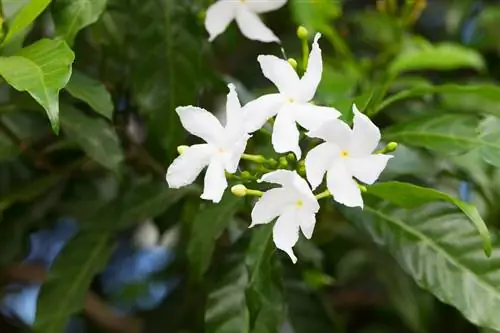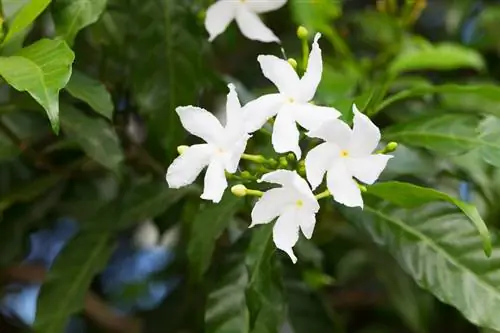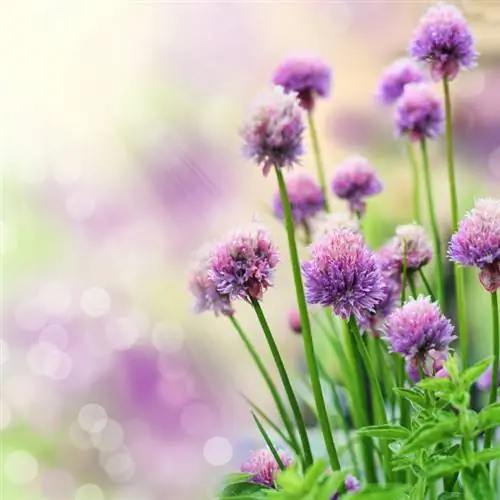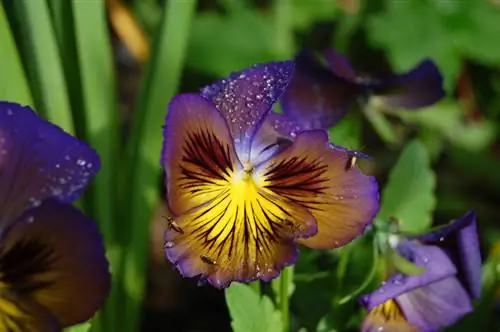- Author admin [email protected].
- Public 2023-12-16 16:46.
- Last modified 2025-01-23 11:20.
The perennial jasmine only blooms profusely if all care requirements are met. What you need to consider if you want to care for jasmine in the pot, in the flower window or on the balcony.

How do I care for jasmine properly?
To properly care for jasmine, water regularly with soft water, fertilize at least every two weeks, repot if necessary, cut in February or March and ensure adequate ventilation. Overwinter the plant in a bright, cool place without fertilizer or pruning.
How to water jasmine?
Jasmine needs a lot of moisture during the growing season. Water the plant in the pot or bucket regularly. If the jasmine is in direct sun, you need to water it more often. When caring for the flower window, ensure high humidity by spraying.
The plant cannot tolerate waterlogging. Pour off excess water immediately. Make sure that waterlogging never occurs.
Use the softest possible rainwater to water jasmine. If necessary, stale tap water will also work.
How much fertilizer does the plant need?
Plants freshly repotted in spring do not need any fertilizer at first. They are only fertilized for the first time after a few weeks.
All other jasmines should be fertilized at least every two weeks with a liquid flower fertilizer (€12.00 on Amazon).
Does jasmine need to be repotted?
Repot jasmine whenever the roots grow out of the pot. If the plant suffers from a lack of nutrients, which is noticeable through yellow leaves, you should plant the jasmine in fresh soil.
The best time to repot is spring, when you take the jasmine out of its winter quarters.
When and how is jasmine cut?
Jasmine only blooms on young shoots. It is best to cut the plant in February or March. Remove older shoots. The jasmine branches out at the interfaces and becomes bushier overall.
You should rejuvenate the jasmine by cutting it back to a third every three to four years at the latest. The plant then stops flowering for one to two years.
What diseases occur?
Diseases only occur if the jasmine is too moist or too dry. Ensure good ventilation to prevent mold and fungus growth.
What pests should you watch out for?
Aphids, mealybugs and spider mites are more common problems, especially in winter quarters. A severe infestation indicates that the plant is too warm or is not ventilated enough.
Pests also occasionally appear in the flower window. You can prevent this if you ventilate the location regularly.
Does jasmine need to be overwintered?
Real jasmine is not hardy - in contrast to false jasmine or scented jasmine. Therefore, always grow the plant in a pot or bucket.
Jasmin enjoys staying on the terrace or balcony in summer. As soon as it gets cold outside, the plant needs to be brought indoors.
- Short slightly before overwintering
- check for pests
- Look for a bright, cool location
- ventilate more often
- water moderately
- no more fertilizing or cutting
Tip
If the jasmine no longer blooms even though you care for it properly, the plant is too old. Rejuvenation, which you carry out in the spring, helps here. In doing so, cut off all old shoots.






